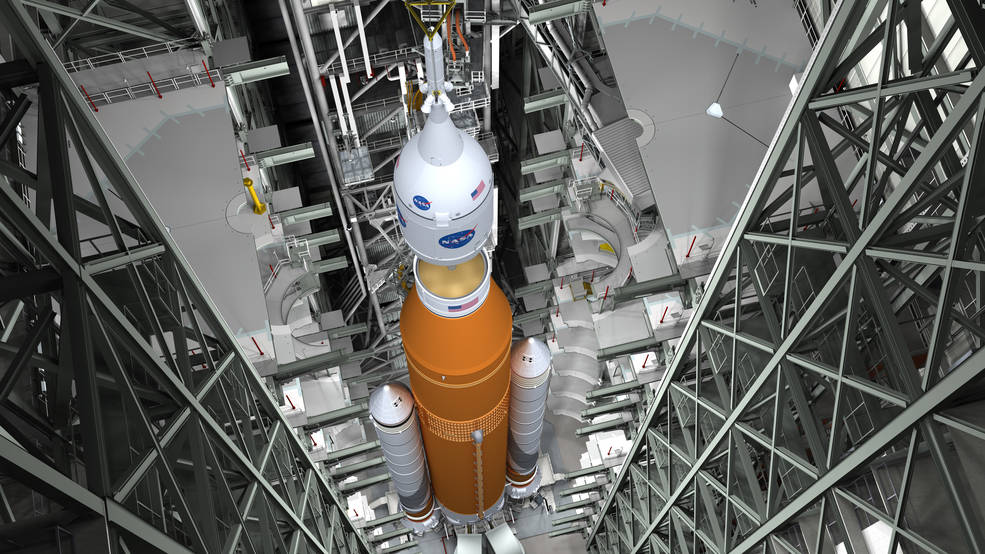The Moon’s going to have more human visitors in the year 2024. NASA has announced that their mission to the Moon, which is named Artemis after the Greek goddess of hunting, has been advanced by four years, from 2028 to 2024. But there’s a catch: they need more dough to do it. $1.6 billion more.
The 2024 date was set by higher-ups in the American government, so NASA will try to comply. However, there’ve been delays in the development of the machinery to get them there. Both the Space Launch System (SLS), which is the rocket that will do the job, and the Orion capsule, which will carry the astronauts, have suffered major delays.
NASA Administrator Jim Bridenstine.
“All of us at NASA should be very proud and excited by this unique opportunity.”
Along with the SLS and the Orion, the Artemis mission also requires an orbiting lunar station. Because of the complexity of the mission, some experts and lawmakers are expressing doubt about the 2024 timeline, saying it’s too aggressive and not realistic.
Besides its complexity and bold timeline, the Artemis mission is notable for another reason. NASA wants at least one of the astronauts that sets foot on the Moon to be a woman. I wonder what words she’ll speak, whomever she is, when she becomes the first woman to set foot on the Moon? Can’t wait to find out.

The President has given his backing to the Artemis mission by requesting an additional $1.6 billion in a budget amendment, though that amount still has to be approved by Congress. According to NASA Administrator Jim Bridenstine, this amount is only an initial investment. It’s not enough to do the job, but enough to get working on the advanced timeline.
“This additional investment, I want to be clear, is a downpayment on NASA’s efforts to land humans on the Moon by 2024,” Bridenstine said in a video.
Though as Bridenstine acknowledges, there’s a lot of work ahead before Artemis can be successful, there’s a hopeful feeling attached to the timeline advancement and the funding announcement. As Bridenstine said, “All of us at NASA should be very proud and excited by this unique opportunity.”
For many Universe Today readers, budgets and Congress and Presidential announcements aren’t that interesting. Governments come and go, but NASA keeps on NASAing no matter what. Though the Artemis mission is challenging and the new timeline only increases that challenge, challenge is what NASA is all about.
Artemis will land on the south pole of the Moon. But the astronauts won’t just land, plant a flag, take some pictures and bring some rocks home. Artemis is part of a grander vision.
At the time of the Apollo mission, it was the grandest, most audacious and complex undertaking in the history of humanity. Now it’s time to go back. And this time it’s too establish a longer-term presence on the Moon which will also be part of a journey to Mars.

The Space Launch System (SLS) will be the most powerful rocket ever built. It will not only get us to the Moon, but to Mars and beyond. The same is true of the Orion capsule. But for Artemis to fulfill its mission, it also requires and orbiting station at the Moon.
This orbiting station is called the Lunar Gateway, and it’s a bold initiative on its own. The Gateway will be small, with an interior about the size of a studio apartment, compared to the interior of the ISS which is as large as a six bedroom house. It’s not designed to host astronauts for the same lengths of time as the ISS. It’s more like transition point than a destination itself.
Astronauts would visit the Gateway and stay for up to three months, rather than the year-long mission that some astronauts have fulfilled on the ISS. It would take about five days to reach the Gateway from Earth, and once there, it’s a staging area for mission to the lunar surface. The Gateway will allow more extensive exploration of the Moon because it can be moved to different orbital locations giving landers better access to scientifically desirable surface locations.

It’s also a stop-over for missions to Mars. As NASA envisions it, missions could stop there and re-supply with oxygen, fuel, food, and even spare parts, before continuing to Mars. The Gateway would also have laboratory space, and robotics and AI would allow experiments to continue even while the Gateway was un-crewed.
This is only the starting point for the Gateway. NASA envisions it growing in the future, the same way the ISS was built, with additional modules and capabilities added over time.
“We. Are. Going.”
NASA Administrator Jim Bridenstine.
The timeline jump seems largely political. There’s no real advantage to getting to the Moon by 2024. Whether NASA can get it done by 2024 or if it takes until 2028 to get there, the main point is they’re working on it. As Bridenstine said, “We. Are. Going.”
That’s all that really matters.


In the 60’s, it took $24 billion over 8 years to get us to the Moon. That’s at least $100 billion in current dollars. With that all out, balls to the wall approach, we still had Apollo 1 and Apollo 13. Oh, and in the 60’s, NASA didn’t have to build a space station in cislunar space from SCRATCH!
Trump and Pence want us to get there in 5 years, and they’re starting with a $1.6 billion DOWN PAYMENT? This is just a bad joke. The total NASA budget between now and 2024 will be a little over $100 billion. In other words, Bridenstine, Trump and company would have to DOUBLE the NASA budget – at a minimum – to make this whole thing even minimally plausible.